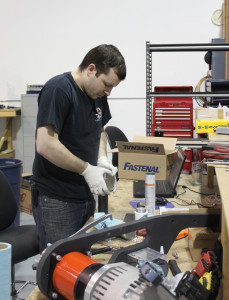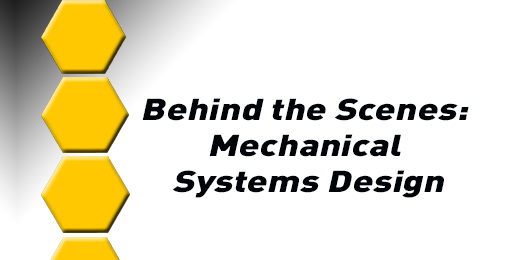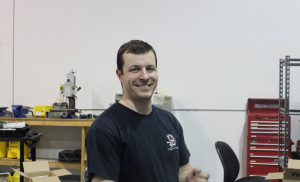What do Grizzly, Husky and Kingfisher all have in common? They all started as an idea. And who helps to bring our bots from a sketch on a whiteboard to the real deal? No other than Clearpath’s design team. To learn more about what really goes on before robots hit production, we sat down with our Mechanical Systems Designer, Matt, to get a behind the scenes look at his role at Clearpath.
How he got here
Matt manages top-end design for robotic platforms: he’s involved with creating the concept, designing, outsourcing required components, and manufacturing – in short, he wears a lot of hats! So what brought Matt to this point? By trade, Matt is a machine tool builder and integrator; “My design capabilities came from my experience. At my previous employer, when things slowed down, I took on more responsibility by learning the skills and eventually making a full time role change from strictly building products, to designing,” says Matt. “At Clearpath, I now get to do both – design and build – it’s perfect for me!”
What’s your typical day look like?
“There’s no such thing as a typical day at Clearpath,” says Matt. “My daily activities really depend on where I am in the design sequence of the project.” There are three key phases that align with Matt’s role: design, source, build. “If I’m starting a design, I spend the day concepting, sourcing parts, and finding what’s most applicable to the solution.” When designing, his focus is on integrating parts and solutions into the final apparatus.
Once the design phase is complete, the project flows into drawing generation and sourcing for manufacturing; “there’s an overlap between drawing and manufacturing, and then the next step is the build stage. That’s when I get to work in the shop and build the first iteration of the product.” The final stage is testing and validating the design structure. “Once we have something we believe in,” says Matt, “we hand it off to production team for mass production.”
Making an Impact
In many traditional business environments, employees receive job outlines with a strict directive, which often limits people to minimum levels of innovation and enjoyment; “Clearpath has introduced me to an open source style of working that allows for individual employees to best use their capabilities as they’ve developed them – it’s an environment that myself, and many other engineers, really enjoy working in.”
At Clearpath, it’s easy to make an impact everyday because everything our team members accomplish is their’s to be accountable for; “I want to take accountability for what I’ve created, and the environment at Clearpath allows me to do that,” said Matt. “The end solution doesn’t only need to meet the customers’ standards, they need to meet my own – As a team member, I’m empowered to produce a product that the Company can be proud of.”
“In fact,” says Matt, “The project I’m currently working on is something I’ve very proud of – it’s awesome!” Over the last four months, Matt has been responsible for turning an idea into reality by producing designs, and now he’s starting on the alpha-build. “In my career, this is the first time that I will have been a part of building something that can drive itself; it’s a nice change of pace and really exciting!”
Ingredients for Success
Matt honed in on a couple key areas for success, for those who are interested in a career on the mechanical engineering side of things…

“It’s important to gain a full understanding of how things are put together so you can incorporate those learnings, processes, and abilities into your designs”
Firstly, gain a full understanding of the complete design-build process. “If you focus on just one element, you’ll miss other areas that make a complete package. So even if your focus is on design, it’s still important to gain a full understanding of how things are put together so you can incorporate those learnings, processes, and abilities into your designs.”
Second, get as hands on as you possibly can! “At the end of the day, you’re only as good as what gets built. If you don’t have any hands-on experience, then it will be very difficult to relate to the production team who will be putting the system together on a full-time basis.”
Third, for those entering or transitioning their careers, find an organization that enables team members to learn and grow daily; “people need to find an employer that will support them through ongoing learning, and structure a work environment that will support their productivity – Clearpath does this for me,” says Matt, and added; “Keep in mind, sometimes you have to start at the bottom of the totem pole and do the ‘dirty work’ before you can find your perfect fit on a team, but that plays in to point number 1 – understanding the complete process.”
Your dream job is waiting for you here.
See what other Clearpathians are up to:
Technical Sales
Autonomy Engineer
Systems Integration Technician
Supply Chain Management



